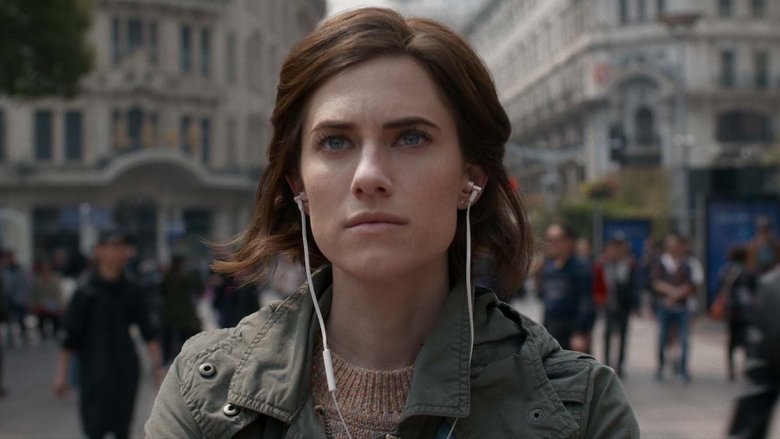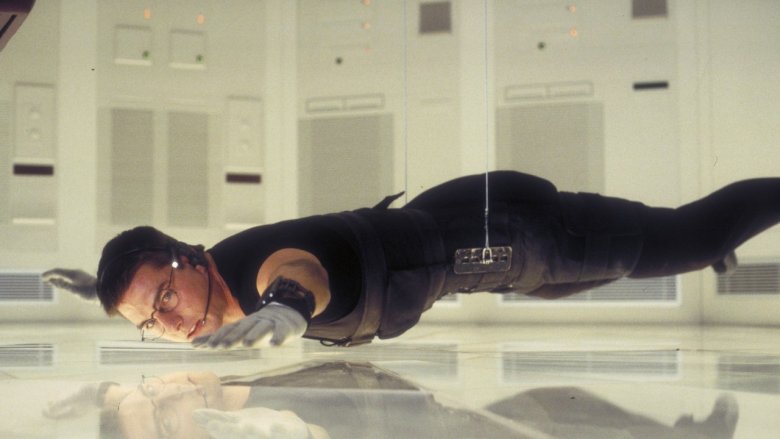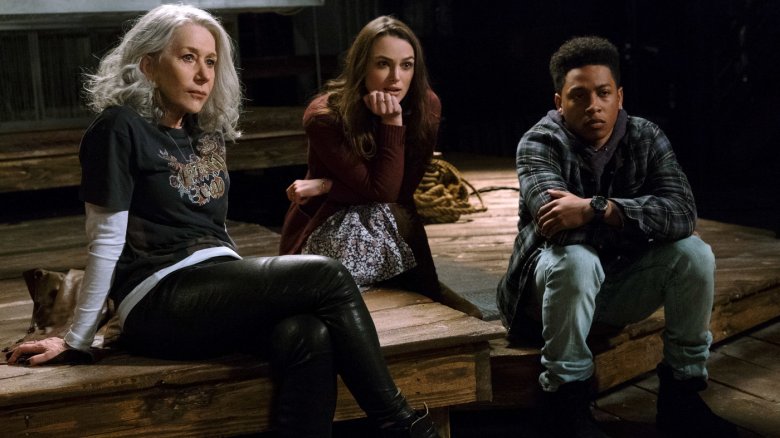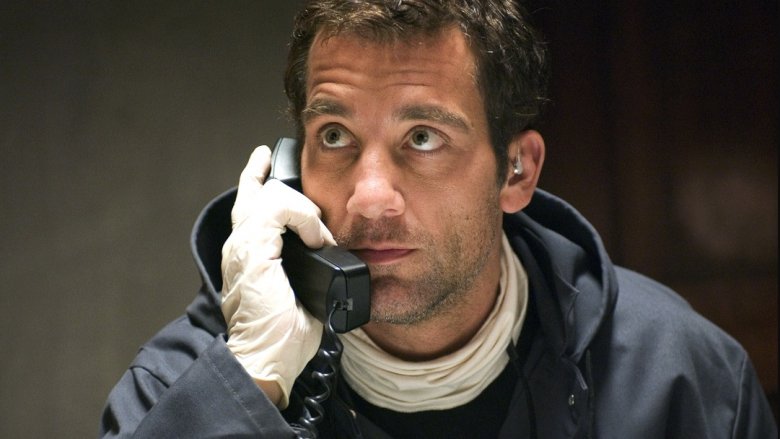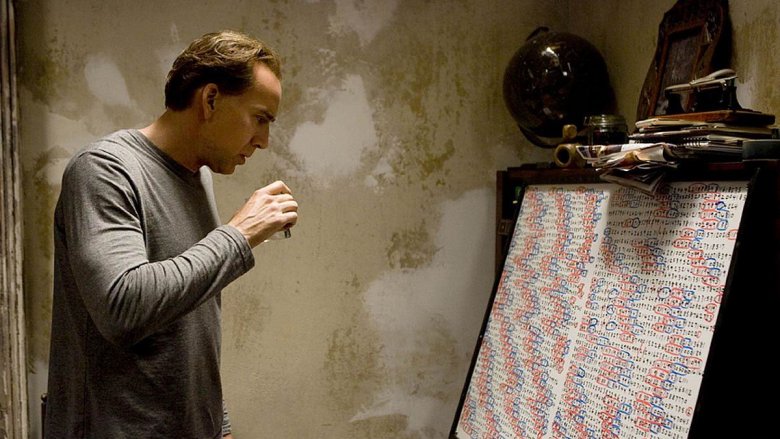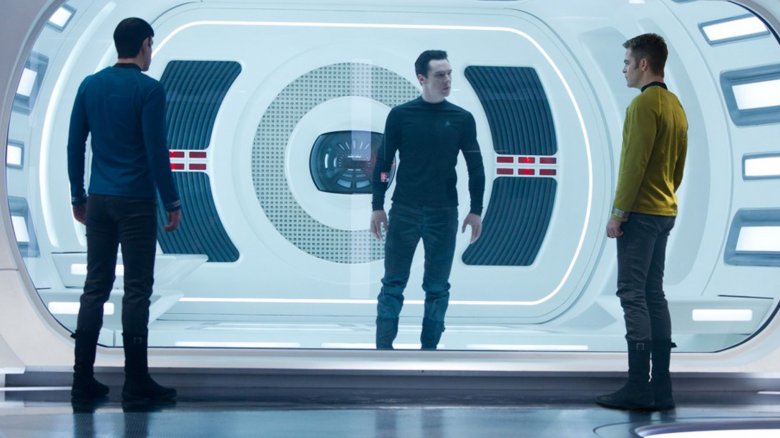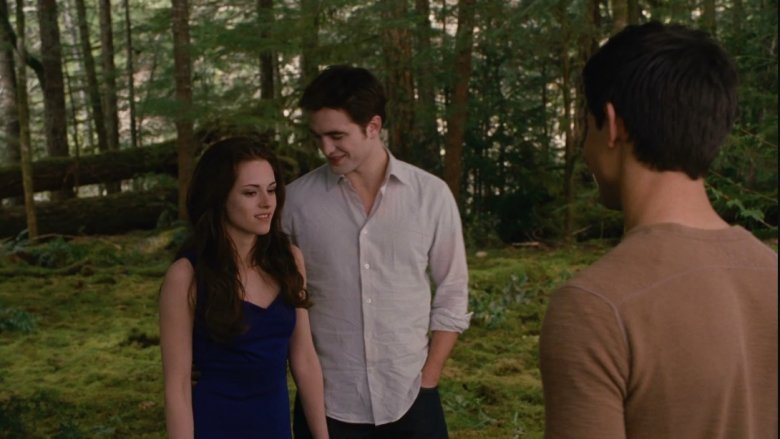Movies That Had Way Too Many Plot Twists
A well-executed plot twist can turn a middling movie into a good movie and a solid movie into a great movie. Would we still be talking about The Sixth Sense or The Usual Suspects all these years later without those legendary twists? It's doubtful. But while plenty of directors and writers want to tap into that undeniable joy of pulling the wool over the eyes of their audiences, there are just as many movies that focus on plot twists to the detriment of everything else. After all, what good is surprising your viewers if they aren't actually emotionally invested in the movie up until that point?
From films that stacked surprises like a shaky Jenga tower to movies that put in just a single, ill-conceived plot element, here are some movies that had way too many plot twists for their runtimes. Needless to say, we're spoiling a whole bunch of movies below.
The Village has multiple monstrous plot twists
The ending of The Sixth Sense was strong enough to make "the Shyamalan twist" a recognizable and anticipated moment in the writer-director's films. Unfortunately, after Unbreakable, he started slipping when it came to the twist department. For example, at the ending of Signs, we learn the aliens were allergic to water, which didn't really live up to the power of "Bruce Willis was a ghost the entire time" or "Samuel L. Jackson was secretly a terrorist." Perhaps that was the reason the filmmaker went a bit overboard in his next film, 2004's The Village. The film follows a group of people living a modest life in a rural village that is occasionally beset by monsters. As it turns out, the creatures are just village elders, enacting a ritual to encourage their younger residents to stay in the village.
But when the blind daughter of the chief elder (Bryce Dallas Howard) ventures out of the village to look for medicine, she's attacked by a real monster...that actually turns out to be a fellow villager wearing one of the monster outfits. The real twist is that once she escapes the village, it turns out that what had appeared to be a 19th-century community was actually just a giant LARP. The film takes place in the modern day, and the village elders have bought and maintained an isolated piece of land in a wildlife preserve to start a new and pure society. We don't blame Shyamalan for trying to one-up himself in terms of twists, but he might have gone a little bit too far on this one.
The Spectre twist left fans expecting more
Depending on your age, Casino Royale and Skyfall are either some of the best James Bond movies or the best James Bond movies. Either way, Daniel Craig has made his mark on the character with his run on the franchise. The eagerly-awaited Spectre was meant to bring everything together, introducing fans to a new version of fan-favorite Bond villain, Blofeld, and showcasing his ultra-powerful and secretive organization, the titular Spectre. Unfortunately, the pressure might've been too much for the filmmakers.
Spectre is a completely bonkers film that links together all of the previous villains in the Craig films into being part of the titular evil organization. As if that wasn't enough, it turns out that Blofeld (Christoph Waltz) is actually Bond's foster brother from childhood who built his entire evil organization for the purpose of destroying Bond, who he sees as a rival for his father's attention. Rather than expanding the world of the franchise, the plot twist shrinks it all down. Instead of going on adventures and proving himself as a superspy against all manner of charismatic supervillains, it turns out the throughline of Craig's Bond films was just a family squabble.
The real Mission: Impossible was following all the plot twists
With half a dozen Mission: Impossible films showcasing new and inventive ways for Tom Cruise to nearly kill himself for our amusement, it might be hard to remember how convoluted and confusing the first Mission: Impossible is. While later films in the franchise would draw upon misdirection and trickery, the actual plot itself usually isn't hard to follow. That's not the case with the first film.
In 1996's Mission Impossible, a routine IMF operation goes wrong when Ethan is accused of being a mole and hunted by his own organization—a common occurrence in the franchise. In order to clear his name, he has to break into the CIA headquarters to steal a list of CIA cover stories that the real mole was trying to sell to an arms dealer. So in order to find out the real mole, Ethan has to pretend to be the mole, steal the real list to replace a fake list, then make sure the real list doesn't actually make it to the arms dealer while also trying to stop the real mole from stealing the real list, all while staying alive and out of jail. Simple, right? That's not even mentioning the disavowed IMF agents, triple-agent femme fatale, and eerily realistic human face masks. Thankfully, the films following (except for the super complicated Fallout) stuck to simple plots and insanely complicated stunts instead of trying to outsmart audiences with a confusing story.
A Simple Favor isn't so simple
Is A Simple Favor a Paul Feig comedy played extremely straight or a murder mystery drama with over-the-top characters and plot twists? Maybe it's both. Either way, it's a movie with a ludicrous number of insane plot twists that read like half a dozen Agatha Christie novels were all stitched together. Anna Kendrick plays Stephanie, a mommy vlogger who falls into an increasingly intimate friendship with Emily (Blake Lively). When Emily's body turns up a little while later, Stephanie suspects that Emily's husband, Sean (Henry Golding), killed his wife in order to collect on her life insurance. As it turns out, it's not that...simple.
Emily's body wasn't really Emily at all. Instead, it was the body of Emily's twin sister, Faith. Emily's real name is Hope, and she plans to pin the murder of her twin on Sean as revenge for him sleeping with Stephanie. It's all very soap opera. Ultimately, the day is saved when a fake plan to extract a confession from Emily with a fake gun is interrupted by Emily trying to murder Sean and Stephanie with a real gun, which is then interrupted by a SWAT team that was watching the events happen on Stephanie's mommy vlog live stream. Twists and turns are part and parcel of the mystery genre, but A Simple Favor just feels convoluted by the time the credits are rolling.
Collateral Beauty left collateral damage with its insane plot twists
Great casting in a film is a bit like a bell curve graph. Get one phenomenal actor in an independent film, and it could be fantastic...or it could be a complete misfire. On the other hand, when a movie is packed to the brim with beloved actors, that's almost just as worrying. It might end up like a Coen brothers film, or you could get Collateral Beauty. Sure, it stars an absurd number of gifted actors like Keira Knightley, Helen Mirren, Kate Winslet, and Edward Norton. And that's not even mentioning the main character, played by Will Smith. But despite the on-screen talent, this movie is out of its mind.
So what's this star-studded film all about? Well, the story follows Howard (Smith), an advertising executive who lost his daughter to a tragic accident years earlier. Ever since, he's been writing letters to the abstract concepts of Love, Time, and Death. Meanwhile, his crooked business partners/estranged friends discover this habit and hire actors to portray the three abstract concepts. Why? Well, they want to film Howard talking to them, erase the actors digitally, and then submit the recording to prove that Howard is unfit to lead the company that they all work at.
Meanwhile, Howard befriends a woman at a bereavement group who divorced her husband after her own daughter died suddenly. By the end of the film, she turns out to have been Howard's actual wife, and the two have been treating each other as strangers for the whole time for some bizarre reason. Additionally, Howard does actually leave the company when his estranged friends' plan is implemented perfectly, but he forgives them because they were doing it to help him. Oh, and the actors playing Love, Time, and Death actually are the personifications of Love, Time, and Death, who decided to help Howard and his friends learn to love again. Talk about a head trip.
You'd have to be an Inside Man to see the twist coming
There are a couple of common plot twists that often pop up in movies, like the "identical twin" or the "it was all a dream" twist. Or perhaps the McGuffin our heroes were chasing was switched out for a different, lesser McGuffin earlier in the film. But if you enjoy predicting these plot twists before they happen, well, chances are good you won't be able to guess the old "secret Nazi diamond" twist until after watching Inside Man.
The film focuses on a bank heist and the hostage negotiator trying to keep the crooks from killing any of the regular people trapped inside the bank with them. And as it turns out, the entire robbery is fake, or at the very least, the bad guys' weapons are. And after the cops mix up who's a hostage and who's a robber, it doesn't seem like anything was actually stolen. But then there's the twist—the bank robbers built an entire fake wall in the vault for the ringleader to wait inside until the cops leave, so he can steal some Nazi diamonds that have been sitting inside the bank since World War II. While whodunits can be a lot of fun, Inside Man is more of a whydunit or a howdunit. How did no one notice the fake wall? Why did the thieving mastermind do all this to enlighten one enterprising hostage negotiator about Nazi shenanigans? Who's checking to make sure any of this makes sense?
Knowing left audiences alienated
Nicolas Cage is known to audiences as a wild actor that can be hard to understand. But despite his crazy reputation, his movies are generally pretty well-constructed and even-keeled (mostly). That isn't the case with Knowing, a film about how Cage's astrophysicist character is the only one who can stop a global extinction event. After his son discovers a series of numbers buried in a time capsule that correspond to various disasters in history (including the September 11 terrorist attacks), Cage notices the numbers also predict disasters that haven't happened yet. Worse, one disaster promises to wipe out the entire planet.
Nicolas Cage using math to save the planet from global extinction is a fine premise on its own, but that's before Knowing hits its stride. Throughout the film, mysterious strangers have been following Cage's son, and it turns out they're actually aliens gathering up the world's children to take them to another planet for some reason. Cage's character is left alone on the planet to die as every living organism is reduced to ashes by a solar flare. What does it all mean? Math is useless; major in humanities instead.
The plot twists in Star Trek: Into Darkness were hard to follow
J.J. Abrams' Star Trek reinvigorated the flagging franchise with an updated aesthetic, a young new cast, and a convenient explanation about how it's a parallel story to the original Star Trek television show instead of simply being a reboot. Following that success, audiences everywhere were eager to see what the sequel would do with the newly fertile story space. As it turns out, Star Trek: Into Darkness was basically just a remake of Star Trek II: The Wrath of Khan, despite many interviews interviews from the filmmakers denying it beforehand—to the point that Abrams publicly regrets the secrecy.
Benedict Cumberbatch playing Khan in a surprise remake of Wrath of Khan might be too much for many fans, but things get even worse when Captain James T. Kirk (Chris Pine) sacrifices himself to save his crew in a nearly identical, inverted shot from Star Trek II, where the original Spock (Leonard Nimoy) also takes one for the team. However, while the original Star Trek films at least waited for a sequel to bring back Spock, Kirk is up and blasting the Beastie Boys again by the end of Into Darkness, thanks to a fortuitous blood infusion from Khan's life-saving body juice. In other words, just watch Wrath of Khan instead of this darkness.
Twilight Breaking Dawn - Part 2 broke audiences with its plot twists
Of all the films on this list, Twilight: Breaking Dawn — Part 2 holds the fewest plot twists, but that's just because the filmmakers only needed one to cross the line into "too many" territory. The story of the films are simple—human Bella Swan (Kristen Stewart) is enamored with her vampire boyfriend Edward (Robert Pattinson) and wants to marry him and become a vampire, in that order. By the time Breaking Dawn rolls around, Bella is newly turned and forced to team up with her vampire-in-laws to battle against a secret vampire society that wants to kill her half-vampire baby. That's when things go off the rails.
Bella, her vampire family, her werewolf friends, and the evil vampire society start killing each other in increasingly violent ways. It's a frenetic turbine of CGI carnage that ends with most of the fan-favorite characters dead. It's also a complete fabrication, a psychic vision from one of the superpowered vampires to show what would have gone down had the battle actually happened. For mega-fans of the book, it likely left them tense in their seats. For everyone else, the revelation that it was all a dream probably left them scratching their heads. Either way, one plot twist was one too many.
The Perfection's plot twists are not so perfect
If you heard anything about Netflix's original horror movie, The Perfection, chances are good you were encouraged to go in as ill-informed as possible. That's because the film has so many twists that part of the pleasure of the film is feeling unsure of what the actual story is about...and partly because it doesn't really hold together by the end. True, the film starts simply enough. Allison Williams of Get Out plays Charlotte, a former cellist prodigy who was forced to hang up her bow to take care of an ailing mother. In turn, her former mentors have found a replacement in Lizzie, played by Dear White People's Logan Browning. That's when things get weird.
Lizzie seems to get infected by an earlier-foreshadowed flu which eventually culminates in her vomiting up wriggling maggots and chopping off her own arm to stop the bugs inside her body from devouring her. But actually, the entire sequence was engineered by Charlotte drugging Lizzie in order to ruin the younger woman's musical career. In yet another twist, it turns out that Charlotte had good intentions. She was trying to help Lizzie escape a life of musical domination and sexual violence at the hands of their shared mentor. In yet another twist, it turns out that Lizzie thinks it's worth the pain in order to truly excel as a musician. But wait, we're not done yet. It actually turns out that she and Charlotte engineered it all to trap their former teacher, chop off his arms and legs, and play a duet together. When a film is almost too confusing to summarize, you've got too many plot twists.
